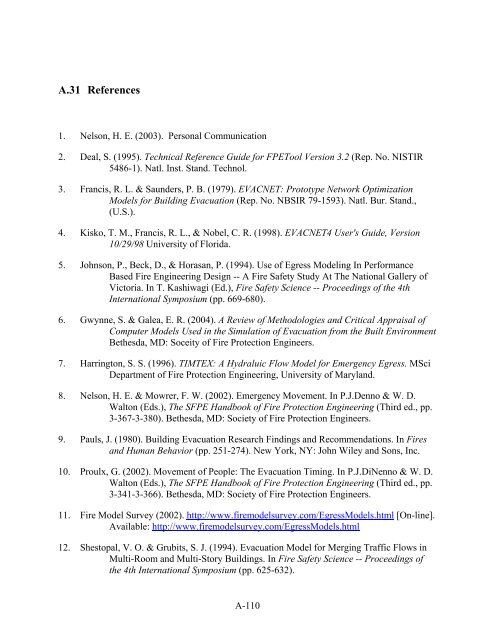A Review of Building Evacuation Models - NIST Virtual Library
A Review of Building Evacuation Models - NIST Virtual Library
A Review of Building Evacuation Models - NIST Virtual Library
Create successful ePaper yourself
Turn your PDF publications into a flip-book with our unique Google optimized e-Paper software.
A.31 References<br />
1. Nelson, H. E. (2003). Personal Communication<br />
2. Deal, S. (1995). Technical Reference Guide for FPETool Version 3.2 (Rep. No. <strong>NIST</strong>IR<br />
5486-1). Natl. Inst. Stand. Technol.<br />
3. Francis, R. L. & Saunders, P. B. (1979). EVACNET: Prototype Network Optimization<br />
<strong>Models</strong> for <strong>Building</strong> <strong>Evacuation</strong> (Rep. No. NBSIR 79-1593). Natl. Bur. Stand.,<br />
(U.S.).<br />
4. Kisko, T. M., Francis, R. L., & Nobel, C. R. (1998). EVACNET4 User's Guide, Version<br />
10/29/98 University <strong>of</strong> Florida.<br />
5. Johnson, P., Beck, D., & Horasan, P. (1994). Use <strong>of</strong> Egress Modeling In Performance<br />
Based Fire Engineering Design -- A Fire Safety Study At The National Gallery <strong>of</strong><br />
Victoria. In T. Kashiwagi (Ed.), Fire Safety Science -- Proceedings <strong>of</strong> the 4th<br />
International Symposium (pp. 669-680).<br />
6. Gwynne, S. & Galea, E. R. (2004). A <strong>Review</strong> <strong>of</strong> Methodologies and Critical Appraisal <strong>of</strong><br />
Computer <strong>Models</strong> Used in the Simulation <strong>of</strong> <strong>Evacuation</strong> from the Built Environment<br />
Bethesda, MD: Soceity <strong>of</strong> Fire Protection Engineers.<br />
7. Harrington, S. S. (1996). TIMTEX: A Hydraluic Flow Model for Emergency Egress. MSci<br />
Department <strong>of</strong> Fire Protection Engineering, University <strong>of</strong> Maryland.<br />
8. Nelson, H. E. & Mowrer, F. W. (2002). Emergency Movement. In P.J.Denno & W. D.<br />
Walton (Eds.), The SFPE Handbook <strong>of</strong> Fire Protection Engineering (Third ed., pp.<br />
3-367-3-380). Bethesda, MD: Society <strong>of</strong> Fire Protection Engineers.<br />
9. Pauls, J. (1980). <strong>Building</strong> <strong>Evacuation</strong> Research Findings and Recommendations. In Fires<br />
and Human Behavior (pp. 251-274). New York, NY: John Wiley and Sons, Inc.<br />
10. Proulx, G. (2002). Movement <strong>of</strong> People: The <strong>Evacuation</strong> Timing. In P.J.DiNenno & W. D.<br />
Walton (Eds.), The SFPE Handbook <strong>of</strong> Fire Protection Engineering (Third ed., pp.<br />
3-341-3-366). Bethesda, MD: Society <strong>of</strong> Fire Protection Engineers.<br />
11. Fire Model Survey (2002). http://www.firemodelsurvey.com/Egress<strong>Models</strong>.html [On-line].<br />
Available: http://www.firemodelsurvey.com/Egress<strong>Models</strong>.html<br />
12. Shestopal, V. O. & Grubits, S. J. (1994). <strong>Evacuation</strong> Model for Merging Traffic Flows in<br />
Multi-Room and Multi-Story <strong>Building</strong>s. In Fire Safety Science -- Proceedings <strong>of</strong><br />
the 4th International Symposium (pp. 625-632).<br />
A-110
















